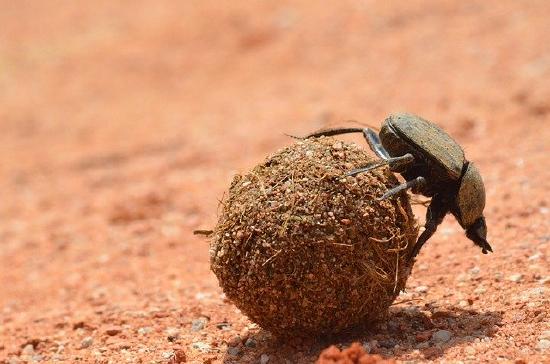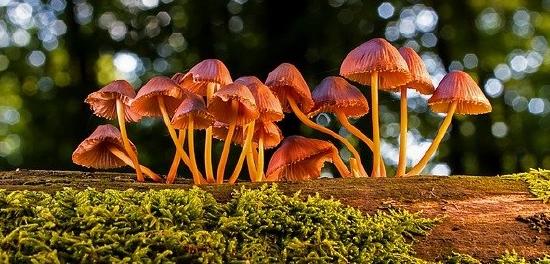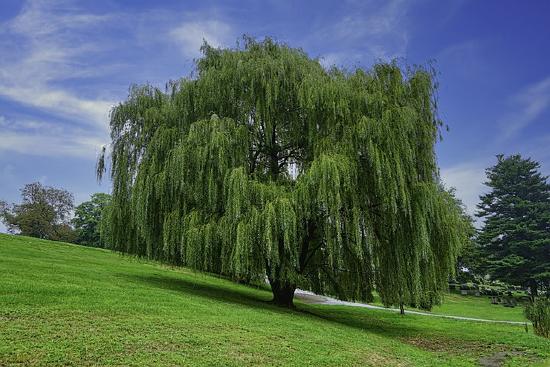24.3: Ecosystems
- Page ID
- 17816
\( \newcommand{\vecs}[1]{\overset { \scriptstyle \rightharpoonup} {\mathbf{#1}} } \)
\( \newcommand{\vecd}[1]{\overset{-\!-\!\rightharpoonup}{\vphantom{a}\smash {#1}}} \)
\( \newcommand{\dsum}{\displaystyle\sum\limits} \)
\( \newcommand{\dint}{\displaystyle\int\limits} \)
\( \newcommand{\dlim}{\displaystyle\lim\limits} \)
\( \newcommand{\id}{\mathrm{id}}\) \( \newcommand{\Span}{\mathrm{span}}\)
( \newcommand{\kernel}{\mathrm{null}\,}\) \( \newcommand{\range}{\mathrm{range}\,}\)
\( \newcommand{\RealPart}{\mathrm{Re}}\) \( \newcommand{\ImaginaryPart}{\mathrm{Im}}\)
\( \newcommand{\Argument}{\mathrm{Arg}}\) \( \newcommand{\norm}[1]{\| #1 \|}\)
\( \newcommand{\inner}[2]{\langle #1, #2 \rangle}\)
\( \newcommand{\Span}{\mathrm{span}}\)
\( \newcommand{\id}{\mathrm{id}}\)
\( \newcommand{\Span}{\mathrm{span}}\)
\( \newcommand{\kernel}{\mathrm{null}\,}\)
\( \newcommand{\range}{\mathrm{range}\,}\)
\( \newcommand{\RealPart}{\mathrm{Re}}\)
\( \newcommand{\ImaginaryPart}{\mathrm{Im}}\)
\( \newcommand{\Argument}{\mathrm{Arg}}\)
\( \newcommand{\norm}[1]{\| #1 \|}\)
\( \newcommand{\inner}[2]{\langle #1, #2 \rangle}\)
\( \newcommand{\Span}{\mathrm{span}}\) \( \newcommand{\AA}{\unicode[.8,0]{x212B}}\)
\( \newcommand{\vectorA}[1]{\vec{#1}} % arrow\)
\( \newcommand{\vectorAt}[1]{\vec{\text{#1}}} % arrow\)
\( \newcommand{\vectorB}[1]{\overset { \scriptstyle \rightharpoonup} {\mathbf{#1}} } \)
\( \newcommand{\vectorC}[1]{\textbf{#1}} \)
\( \newcommand{\vectorD}[1]{\overrightarrow{#1}} \)
\( \newcommand{\vectorDt}[1]{\overrightarrow{\text{#1}}} \)
\( \newcommand{\vectE}[1]{\overset{-\!-\!\rightharpoonup}{\vphantom{a}\smash{\mathbf {#1}}}} \)
\( \newcommand{\vecs}[1]{\overset { \scriptstyle \rightharpoonup} {\mathbf{#1}} } \)
\( \newcommand{\vecd}[1]{\overset{-\!-\!\rightharpoonup}{\vphantom{a}\smash {#1}}} \)
\(\newcommand{\avec}{\mathbf a}\) \(\newcommand{\bvec}{\mathbf b}\) \(\newcommand{\cvec}{\mathbf c}\) \(\newcommand{\dvec}{\mathbf d}\) \(\newcommand{\dtil}{\widetilde{\mathbf d}}\) \(\newcommand{\evec}{\mathbf e}\) \(\newcommand{\fvec}{\mathbf f}\) \(\newcommand{\nvec}{\mathbf n}\) \(\newcommand{\pvec}{\mathbf p}\) \(\newcommand{\qvec}{\mathbf q}\) \(\newcommand{\svec}{\mathbf s}\) \(\newcommand{\tvec}{\mathbf t}\) \(\newcommand{\uvec}{\mathbf u}\) \(\newcommand{\vvec}{\mathbf v}\) \(\newcommand{\wvec}{\mathbf w}\) \(\newcommand{\xvec}{\mathbf x}\) \(\newcommand{\yvec}{\mathbf y}\) \(\newcommand{\zvec}{\mathbf z}\) \(\newcommand{\rvec}{\mathbf r}\) \(\newcommand{\mvec}{\mathbf m}\) \(\newcommand{\zerovec}{\mathbf 0}\) \(\newcommand{\onevec}{\mathbf 1}\) \(\newcommand{\real}{\mathbb R}\) \(\newcommand{\twovec}[2]{\left[\begin{array}{r}#1 \\ #2 \end{array}\right]}\) \(\newcommand{\ctwovec}[2]{\left[\begin{array}{c}#1 \\ #2 \end{array}\right]}\) \(\newcommand{\threevec}[3]{\left[\begin{array}{r}#1 \\ #2 \\ #3 \end{array}\right]}\) \(\newcommand{\cthreevec}[3]{\left[\begin{array}{c}#1 \\ #2 \\ #3 \end{array}\right]}\) \(\newcommand{\fourvec}[4]{\left[\begin{array}{r}#1 \\ #2 \\ #3 \\ #4 \end{array}\right]}\) \(\newcommand{\cfourvec}[4]{\left[\begin{array}{c}#1 \\ #2 \\ #3 \\ #4 \end{array}\right]}\) \(\newcommand{\fivevec}[5]{\left[\begin{array}{r}#1 \\ #2 \\ #3 \\ #4 \\ #5 \\ \end{array}\right]}\) \(\newcommand{\cfivevec}[5]{\left[\begin{array}{c}#1 \\ #2 \\ #3 \\ #4 \\ #5 \\ \end{array}\right]}\) \(\newcommand{\mattwo}[4]{\left[\begin{array}{rr}#1 \amp #2 \\ #3 \amp #4 \\ \end{array}\right]}\) \(\newcommand{\laspan}[1]{\text{Span}\{#1\}}\) \(\newcommand{\bcal}{\cal B}\) \(\newcommand{\ccal}{\cal C}\) \(\newcommand{\scal}{\cal S}\) \(\newcommand{\wcal}{\cal W}\) \(\newcommand{\ecal}{\cal E}\) \(\newcommand{\coords}[2]{\left\{#1\right\}_{#2}}\) \(\newcommand{\gray}[1]{\color{gray}{#1}}\) \(\newcommand{\lgray}[1]{\color{lightgray}{#1}}\) \(\newcommand{\rank}{\operatorname{rank}}\) \(\newcommand{\row}{\text{Row}}\) \(\newcommand{\col}{\text{Col}}\) \(\renewcommand{\row}{\text{Row}}\) \(\newcommand{\nul}{\text{Nul}}\) \(\newcommand{\var}{\text{Var}}\) \(\newcommand{\corr}{\text{corr}}\) \(\newcommand{\len}[1]{\left|#1\right|}\) \(\newcommand{\bbar}{\overline{\bvec}}\) \(\newcommand{\bhat}{\widehat{\bvec}}\) \(\newcommand{\bperp}{\bvec^\perp}\) \(\newcommand{\xhat}{\widehat{\xvec}}\) \(\newcommand{\vhat}{\widehat{\vvec}}\) \(\newcommand{\uhat}{\widehat{\uvec}}\) \(\newcommand{\what}{\widehat{\wvec}}\) \(\newcommand{\Sighat}{\widehat{\Sigma}}\) \(\newcommand{\lt}{<}\) \(\newcommand{\gt}{>}\) \(\newcommand{\amp}{&}\) \(\definecolor{fillinmathshade}{gray}{0.9}\)The black beetle in Figure \(\PageIndex{1}\) has made a ball from the dung (feces) of a mammal and is rolling it away from the dung pile. After forming a ball from the dung, the beetle rolls the ball in a straight line, despite all obstacles, to a safe location so other dung beetles can’t steal it. Dung beetles can roll dung balls that are up to ten times their own weight. What do they do with all that dung? Generally, they bury it. Then, depending on the species of dung beetle, they either use the dung ball as a source of stored food or lay their eggs inside it. In the latter case, when larvae hatch from the eggs, they have a nutritious food source handy. Yum!

Why focus on this poop-consuming insect? Dung beetles play a very important role in agricultural areas as well as in many natural ecosystems. By burying and consuming dung, they improve nutrient recycling and soil structure. They also protect livestock from pests such as flies that would otherwise be attracted by dung. Dung beetles save the American cattle industry an estimated $380 million a year by burying livestock feces. This is just one of a multitude of valuable services that are provided to humans by ecosystems and their organisms.
What Is an Ecosystem?
Like other systems, an ecosystem is a set of interacting components that form a complex whole. The interacting components of an ecosystem are all of its living things and its nonliving environment. The nonliving environment includes such abiotic factors as temperature, water, sunlight, and minerals in the soil. A community is the biotic part of an ecosystem. It consists of all the populations of all the species that live and interact in the ecosystem. The abiotic and biotic parts of an ecosystem are linked together by flows of energy and cycles of nutrients through the system.
There is no widely agreed upon way to delineate a specific ecosystem. Theoretically, ecosystems can vary tremendously in size. Consider a forest as an example. It might cover hundreds or even thousands of acres, forming a large ecosystem in which an individual tree is of little consequence. However, an individual tree can also be considered an ecosystem, with millions of organisms living in and on it, ranging from microbes to small mammals. Even a single leaf can be considered an ecosystem. Several generations of an aphid population can exist over the lifespan of the leaf, as in Figure \(\PageIndex{2}\). Each of the aphids, in turn, supports a diverse community of bacteria.

Ecosystem Processes
Ecosystem processes move energy and matter through the biotic and abiotic components of the system. These processes begin with primary production by producers. The energy that flows through almost all ecosystems is obtained primarily from the sun and enters ecosystems through the process of photosynthesis. This process is carried out by producers that may include plants, certain microbes, and/or algae. These producers capture energy from sunlight and use it to turn inorganic carbon dioxide (from the atmosphere) and water into organic carbon molecules and oxygen.

Mineral Nutrient Recycling
Ecosystems continually take in energy from the wider environment around them. Mineral nutrients, on the other hand, are mostly recycled within ecosystems among living things and abiotic components of ecosystems. Nitrogen in the atmosphere, for example, is taken up by certain soil bacteria, which change the nitrogen to a form that plants can use. From plants, nitrogen cycles to animals and eventually to decomposers, which return nitrogen to the soil. In most terrestrial ecosystems, nitrogen is a limiting factor in plant growth. A limiting factor is any factor that constrains the population size of one or more species in an ecosystem. Because most terrestrial ecosystems are nitrogen-limited, nitrogen cycling is an important control on ecosystem production. Other nutrients that are recycled within ecosystems include phosphorus, potassium, and magnesium.
Ecosystem Goods and Services
Ecosystems provide a variety of goods and services upon which people depend. Without healthy natural ecosystems, we could not survive as a species.
Ecosystem Goods
Ecosystem goods include tangible, material products of ecosystem processes, including foods such as wild game and fruits, construction materials such as wood and bamboo, and medicinal plants such as the willow tree pictured in Figure \(\PageIndex{4}\). Ecosystem goods also include less tangible things, such as ecosystem features that provide tourist attractions and recreational opportunities. The genes in wild plants and animals are another ecosystem good. These organisms provide a storehouse of genetic material that can be used to improve domestic species.

Ecosystem Services
The services ecosystems provide maybe even more important than the goods, yet they have traditionally been taken for granted. They include processes that maintain the water cycle, provide oxygen to the air, remove greenhouse gases from the atmosphere, filter pollutants from water, and pollinate crops. These services not only have economic value; they are also invaluable for the maintenance of human life.
As an example, consider the ecosystem service of pollination. Most flowering plants require help from pollinators such as insects and birds to produce fruit and seeds. Pollinators play an essential role in the production of more than 150 food crops in the United States, including almost all fruit and grain crops, from apples to alfalfa. The single most important pollinator of crops is the honey bee (like the one pictured in Figure \(\PageIndex{5}\)). Honey bees provide an estimated 1.6 billion dollars of natural pollinating services to agriculture in the United States alone.

Feature: Human Biology in the News
One of the biggest and potentially most devastating mysteries taking place in ecosystems in recent years is the decline of honey bees. Beekeepers normally expect some of their honey bees to die off from one season to the next, but recent losses are double of those from the past. The dramatic reduction in honey bee populations has made the news not only because it is so shocking in its devastation but also because of the extremely valuable ecosystem service that honey bees provide as pollinators. Beekeepers must spend more money to try to keep their bees alive and to start new colonies to replace those that have died out. This cost is passed on to farmers who make use of honey bee pollinators. Ultimately, the cost is passed on to consumers like you.
Researchers are desperately trying to find the answer to the mysterious demise of honey bees so they can devise plans to protect them. One possible cause that has been identified recently is a parasitic mite of the aptly named species Varroa destructor. Shown in Figure \(\PageIndex{6}\), this mite has been called the “vampire” of the bee world because it feeds on the insect equivalent of blood (called hemolymph) of both adult and juvenile honey bees. Imagine a blood-sucking mosquito the size of a dinner plate attacking you for your blood. That’s about how large the vampire mites are relative to their honey bee hosts. Worse yet, individual bees are often attacked by multiple mites. In addition, besides sucking the bee’s “blood,” the mites also transmit other pathogens that suppress the bee host’s immune system. No wonder the mites are taking such a toll on honey bee populations!

Chemicals called miticides are available that can kill Varroa mites. Unfortunately, honey bees are also adversely affected by the chemicals. The use of miticides may even be contributing to honey bee mortality. Another problem is that the mites are developing resistance to the most commonly used miticides. One potential strategy currently under investigation is to breed honey bees that are naturally resistant to the mites. However, that strategy may take a long period of time to come to fruition, if indeed it does.
In the meantime, another strategy can be implemented. That strategy is to strengthen honey bee immune systems by providing bees with a greater variety of easily accessible forage plants. Evidence suggests that when honey bees have optimal nutrition, they are better able to deal with mites and other potential causes of mortality. However, modern agribusiness and the growth of cities have decreased the amount and variety of natural flowering plants that bees need to thrive. You don’t have to be a beekeeper or scientist to help counter this trend and contribute to honey bee health and survival. If you are a homeowner, you can grow wildflowers in your yard, making sure to include species that bloom at different times of the year.
Review
- Define ecosystem, and identify the components that make up an ecosystem.
- How do ecosystems function?
- What materials are recycled in ecosystems?
- Define and give examples of ecosystem goods and services.
- Why do you think farmers sometimes use a fertilizer that contains nitrogen on their crops?
- Decomposers:
- A. are primary producers.
- B. do not play important roles in ecosystems.
- C. help recycle nutrients in an ecosystem.
- D. are usually abiotic.
Explore More
Watch this video to learn about the importance of biodiversity
Watch this video to learn more about the population decline of bees
Attributions
- Dung beetle by Bayhaus via Pixabay license
- Aphidoidea by Thomas Bresson, licensed CC BY 3.0 via Wikimedia Commons
- Mushrooms by adeg via Pixabay license
- Weeping willow by daledbe via Pixabay license
- Honey bee by Orangeaurochs, licensed CC BY 2.0 via Wikimedia Commons
- Vorroa mites, public domain via Wikimedia Commons
- Text adapted from Human Biology by CK-12 licensed CC BY-NC 3.0


